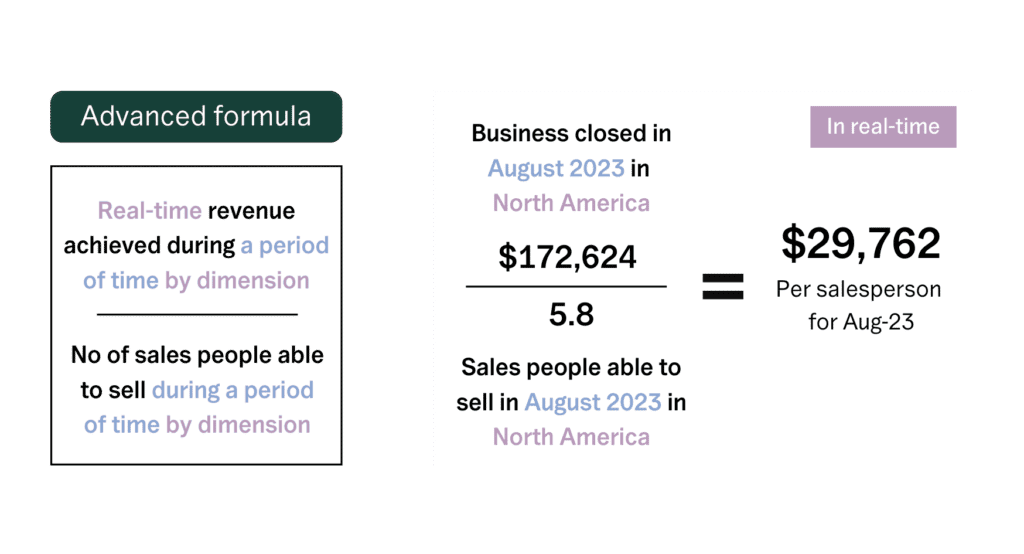When measuring sales performance, traditional metrics like quota attainment and activity levels have long dominated the conversation. Did a rep hit their target? How many calls or emails did they make? These questions are easy to answer—but they don’t tell the whole story.
Measuring sales productivity isn’t just about whether a number was reached—it’s about understanding how efficiently revenue is generated based on available sales capacity. In a world where efficiency is as critical as growth, understanding and optimizing sales productivity is no longer optional—it’s a necessity.
Why measuring Sales Productivity matters
Measuring sales productivity allows businesses to evaluate how effectively their teams convert effort into revenue. Unlike traditional activity-based metrics, it evaluates performance in relation to capacity—focusing on what an organization is actually able to produce with the resources available.
At its core, sales productivity follows this formula:
Sales Productivity = (Revenue Achieved in a Period by Dimension) / (Number of Sales Reps Able to Sell in That Period by Dimension)

This formula highlights two critical factors:
- Revenue achieved in a given timeframe – The total revenue generated, broken down by relevant dimensions (e.g., region, product line, segment).
- Sales reps actively selling – The number of sellers who were fully ramped and capable of closing business in that same timeframe.
Unlike traditional sales metrics, measuring sales productivity accounts for actual production across the business dimensions —providing a more accurate measure of true sales performance. Businesses that prioritize measuring sales productivity gain insights into revenue generation, sales efficiency, and overall performance.
Why traditional metrics fall short
Many companies still rely on quota attainment as their primary measure of success due to the complexity of the calculation sales productivity accurately. But quota attainment is a lagging indicator—it tells you whether a number was reached, but not how efficiently or sustainably it was achieved.
For example:
- A rep could hit quota by closing one large, one-time deal, which doesn’t reflect ongoing productivity.
- Another rep might miss quota despite strong pipeline velocity due to external market factors.
- A team could be burning excessive resources to reach targets, making success unsustainable.
Sales productivity moves beyond raw output to evaluate whether sales teams are performing at the right level for long-term success.
Sales Productivity vs. Sales Efficiency: what’s the difference?
While the two are often used interchangeably, sales productivity and sales efficiency measure different things:
- Sales Productivity = How much revenue is generated per rep over a given timeframe.
- Sales Efficiency = The cost-effectiveness of generating that revenue (e.g., cost per deal, sales cycle length).
Both play a crucial role in revenue performance. Productivity helps assess how well sales teams are utilizing their capacity, while efficiency ensures that revenue growth remains sustainable. By understanding both, organizations can refine their sales strategies to optimize outcomes at scale.
Why sales productivity matters for Revenue leaders
RevOps isn’t just about reporting on sales metrics—it’s about enabling the organization to optimize its sales capacity and execution strategy. Productivity plays a key role in that effort by helping answer critical business questions, such as:
- Are we fully utilizing our sales capacity?
- How do we improve revenue per rep without overloading them?
- Which segments, regions, or product lines are underperforming relative to sales headcount?
- Where should we adjust hiring, training, or territory allocation to maximize performance?
By understanding how much revenue is being generated per rep, organizations can make smarter, more scalable decisions around sales planning and execution.
Key metrics that shape sales productivity
While quota attainment provides a surface-level view of performance, sales productivity requires a more comprehensive approach. Leading RevOps teams track a combination of efficiency-based and capacity-based metrics to gain a full picture of performance.
- Pipeline velocity
How quickly opportunities move through the sales funnel. Faster movement = higher revenue potential. - Revenue per rep
A direct measure of individual seller efficiency—how much revenue each sales rep generates.
- Ramp time
The time it takes for a new rep to become fully productive. The faster the ramp, the greater the overall sales capacity.
- Win rates by segment
Understanding which customer segments generate the highest conversion rates helps teams focus efforts where they matter most.
- Time allocation per rep
What percentage of a rep’s time is actually spent selling versus administrative or non-revenue-generating tasks?
Tracking and optimizing these factors creates a clearer path to improving sales productivity—not just measuring past performance.
How to optimize sales productivity
Measuring sales productivity and increasing it isn’t about pushing reps to work harder—it’s about removing barriers to efficiency and ensuring that effort is focused in the right places.
- Align sales capacity with revenue goals
Productivity isn’t just an individual metric—it’s an organizational one. If too few reps are responsible for an ambitious revenue target, the productivity may not be there to hit target. Regularly assess whether sales headcount and structure align with business goals. - Improve ramp time
The faster reps become productive, the greater the overall revenue potential. Reducing ramp time by even a few weeks can have a significant impact on productivity at scale. - Use data to identify underperforming areas
Not all segments or territories contribute equally. Analyzing productivity at a business dimensional level helps prioritize efforts in high-performing areas and diagnose issues in underperforming ones. - Prioritize coaching over more activity
More calls and emails don’t always equal better results. High-productivity teams invest in targeted coaching, better enablement tools, and data-driven selling techniques.
The business impact of optimized sales productivity
Sales productivity isn’t just a sales problem—it’s a business-wide opportunity. When sales teams operate at peak productivity:
✅ Revenue growth becomes more predictable and scalable
✅ Hiring decisions become more strategic—avoiding overstaffing or under-resourcing
✅ Customer experience improves—as reps spend more time on meaningful interactions
✅ Profitability increases—as revenue grows without a proportional rise in costs
In short: higher sales productivity means higher ROI on every rep, resource, and initiative.
Conclusion
Measuring sales productivity is one of the most misunderstood but critical sales performance metrics. While traditional measurements like quota attainment tell part of the story, true productivity lies in how efficiently revenue is generated across available sales capacity.
For RevOps teams, understanding and optimizing sales productivity is the key to scalable, profitable efficient growth. By moving beyond simple activity metrics and focusing rather on productivity, ramp times, efficiency and resource alignment, organizations can turn sales productivity into a true competitive advantage.
It’s not about working harder—it’s about working smarter. And when sales teams, RevOps, and leadership align around sales productivity metrics, growth becomes a matter of strategy, not just effort.
What's next?
If you’re looking to improve sales productivity at scale, it starts with the right insights. Lative helps organizations calculate and analysis your Sales Productivity and Efficiency and build sales capacity plans with real-time revenue performance—so you can track, measure, and optimize your sales productivity with clarity and confidence.

